Add this eBook to your basket to receive access to all 395 records. Our indexes include entries for the spelling pilcher. In the period you have requested, we have the following 395 records (displaying 371 to 380): These sample scans are from the original record. You will get scans of the full pages or articles where the surname you searched for has been found. Your web browser may prevent the sample windows from opening; in this case please change your browser settings to allow pop-up windows from this site. Student Electrical Engineers (Student I. E. E.)
(1939)
The Institution of Electrical Engineers was founded in 1871 under the name of The Society of Telegraph Engineers, and incorporated by royal charter in 1921. The list of members, corrected to 1 September 1939, gives the names and addresses of the various grades of members. Members (M. I. E. E.) and Associate Members (A. M. I. E. E.) were entitled to describe themselves as Chartered Electrical Engineers. Then there are the Associates (Associate I. E. E.), Companions (Companion I. E. E.), Graduates (Graduate I. E. E.) and Students (Student I. E. E.). The names are given in bold, surname first; before each name is the year of attaining that grade; and for the higher grades the year of each lower grade is also given, e. g. (G. 1931). | Sample scan, click to enlarge

| British Civil Servants
(1940)
The British Imperial Calendar lists civil servants in Britain, arranged according to the organizational structure of the state, and shows their qualifications and salaries. | Sample scan, click to enlarge
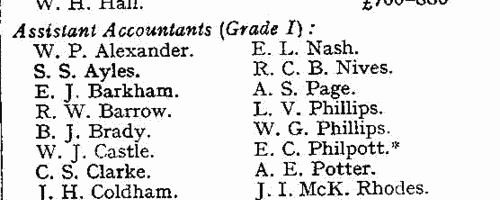
| Esperantists (1945)
New members joining the British Esperanto Association
| Sample scan, click to enlarge
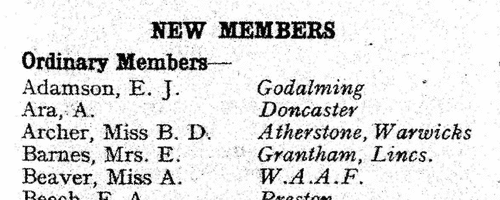
| Boys entering Sherborne School
(1948)
The grammar school at Sherborne in Dorset, which doubtless existed from the creation of the diocese of Sherborne in 705, was refounded by king Edward VI in 1550. At the quatercentenary in 1950, a fourth edition of the Sherborne Register was published, listing boys entering the school during those four centuries. In truth, the materials for this register survive but fitfully before 1823; for some years, no names are known; sometimes all that is known is a surname. But from 1823 onwards the lists and the details get steadily more comprehensive. By the 20th century the boys are listed alphabetically by surname under term of entrance. Surname is given in bold, then christian names, name of father (surname and initials) and address; year of birth; house (a, School House; b, Abbey House; c, The Green; d, Harper House (formerly The Retreat); f, Abbeylands; g, Lyon House; h, Westcott House); whether represented the school at cricket (xi), football (xv), shooting (viii), &c.; year of leaving; summary of degrees, career &c.; and (in italics), address as of 1950. Names in the early lists marked with an asterisk are found inscribed on the oak panelling or on the stone walls of the former schoolroom. (F) in the lists indicates a foundationer, receiving free education: after 1827, when this privilege was restricted to boys from Sherborne and neighbourhood, nearly all foundationers were day-boys. | Sample scan, click to enlarge
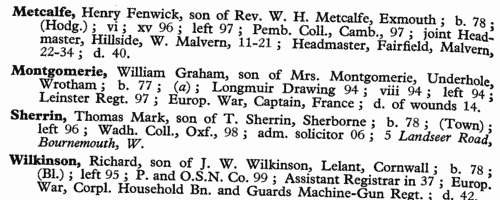
| Doctors in London
(1948)
The Medical Directory was split into several sections. The London section covered all medical practitioners resident within the London postal district. Each year a schedule was sent to each doctor to be returned to the publishers, so as to keep the directory up to date. In the directory the doctor's name is given first, in bold, surname first, in capitals; then current address. Next are the qualifications; the italic abbreviations in parentheses following the qualifications indicate the medical school at which they were gained. Then there is a list of posts and honours within the profession, starting with those then current; previous posts are preceded by the word 'late'. Finally, brief details are given of any publications. | Sample scan, click to enlarge
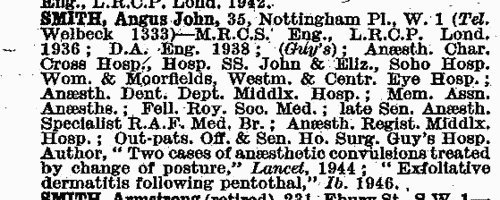
| Doctors trained in Britain or Ireland but living abroad
(1948)
The Medical Directory was split into several sections. The Practitioners Resident Abroad section covered all medical practitioners who, having qualified in Britain or Ireland, were living abroad. Each year a schedule was sent to each doctor to be returned to the publishers, so as to keep the directory up to date. In the directory the doctor's name is given first, in bold, surname first, in capitals; then current address. Next are the qualifications; the italic abbreviations in parentheses following the qualifications indicate the medical school at which they were gained. Then there is a list of posts and honours within the profession, starting with those then current; previous posts are preceded by the word 'late'. Finally, brief details are given of any publications. Inclusion of names in the list did not imply a right to practise in the country of residence. | Sample scan, click to enlarge
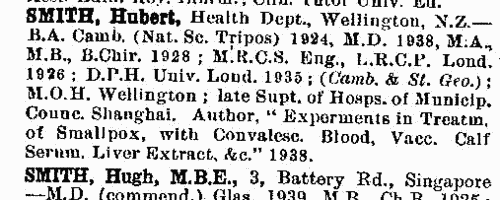
| Boys entering Aldenham School
(1950)
Aldenham School in Hertfordshire is a public school originating as an Elizabethan grammar school. The Aldenham School Register was first published in 1898, but this tenth edition, by R. J. Evans, and published in 1969, comprised only living old boys who had entered the school from 1900 onwards, together with those who had entered the school before 1900 and who had responded to a questionnaire. There is thus a general presumption that all the boys mentioned were alive in 1969. The boys are listed alphabetically by surname under the term in which they entered the school. Full name is given, in bold, surname first. Then an abbreviation indicating their house (B, Beevor's; K, Kennedy's; M, McGill's; P, Paull's; SH, School House); the period of stay at the school; address as of 1969; father's name, occupation and residence (where the father had also studied at the school, his name is given in capitals with the year of his entry); brief details of any achievements at the school (particularly at sports); and the briefest of details of subsequent career. | Sample scan, click to enlarge
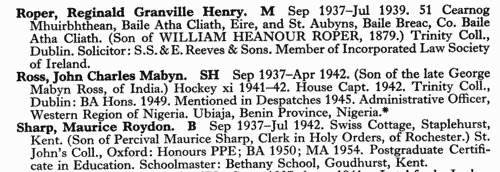
| British Dentists
(1950)
The Dentists Register is the official register of British dental practitioners. For each dentist the original certificate number is given; name (surname first, in bold; in the case of married women, maiden name is also usually given); address (in italics); date of registration; and the qualification entitling registration, with any additional qualifications, with year and place of qualification. Many of the older dentists, already practising by 1921, were qualified by virtue of the Dentists Act of that year. | Sample scan, click to enlarge

| Estates of the Deceased: Notices under the Trustee Act
(1950)
Under the Trustee Act 1925 s. 27, notices were gazetted giving the names of deceased (surname first, in capitals); address, description, and date of death; names, addresses and occupations of persons to whom notices of claims against the estate were to be given, and names (in brackets) of personal representatives; and the date on or before which notices of claim were to be given. March 1950. | Sample scan, click to enlarge

| Boys entering Epsom College
(1951)
The Royal Medical Benevolent College at Epsom in Surrey was founded in 1853 for the orphans of the medical profession, and evolved to become a public school still largely catering for sons of doctors and surgeons. In 1955 this register of pupils, from 1855 to 1954, edited by T. R. Thomson, was published. The sample scan is from 1880. The entries are arranged alphabetically by surname under year of entrance to the school; surname first (in bold), christian names, and then (in most cases), the father's name, occupation and address: then the boy's year of birth (b.), year of leaving (l.), occupation, and, where known, year of death (d.). From 1880 onwards the house to which the boy belonged is also indicated: the boarding houses were Carr (C.), Forest (F.), Granville (G.), Holman (H.), Propert (P.) and Wilson (W.); and Crawfurd (Cr.), Hart Smith (H. S.) and Rosebery (R.) are the houses for day scholars. From 1920 onwards the pupils' addresses as of 1955 (where living and still known) are added at the end of each entry. This is the index to the year 1951, when Henry William Fernehough Franklin was headmaster. Of course, the future of most boys entering in this year was still to unfold by 1955, and so their details are just those of year of birth and parentage, but from 1945 onwards their intended occupations are also given, in brackets. | Sample scan, click to enlarge

|
Research your ancestry, family history, genealogy and one-name study by direct access to original records and archives indexed by surname.
|











